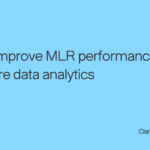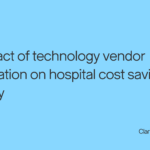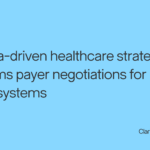This is part one of our three-part series about how health plan leaders can leverage healthcare claims data to reduce costs, strategically grow their networks, provide best-in-class member services, and enhance outcomes for their members. Rising healthcare costs pressure health plans to find creative ways to reduce costs without compromising patient outcomes. Analyzing healthcare claims data is one of the most powerful tools for identifying cost savings opportunities. Looking across claims for their members, health plans can identify high-cost areas and variations in care quality and outcomes. By linking internal claims data to external datasets, health plans can start to better understand member populations, healthcare and utilization trends, and cost. Cost benchmarking — comparing a health plan’s cost data against industry benchmarks — is fundamental to cost management. These comparisons can identify areas in which expenses surpass industry averages. For example, if cardiac care costs are notably higher than the benchmarks, health plans can develop targeted strategies to reduce costs. They might accomplish this by negotiating better rates with providers or optimizing care delivery processes. Additionally, cost benchmarking facilitates competitive positioning. When payers use healthcare claims data to understand their plans’ performance relative to competitors, they can cultivate improvements and innovations. With this data, plans can not only meet industry averages, but exceed them with better value for their members. Understanding utilization patterns can help both health plan administrators identify high-cost areas of care. For example, an unusually high number of emergency room visits might signal insufficient primary care or a lack of patient education. Similarly, frequent, and/or unnecessary testing can lead to significant and avoidable expenses. These patterns provide insights to health plans that can be used to devise targeted interventions, such as improving access to primary care or educating patients and providers. By addressing these issues, both payers and providers can reduce unnecessary expenditures and guide patients toward the right care at the right time, and the right place, often substantially reducing unnecessary costs. Robust preventive care is essential for reducing long-term healthcare costs for payers. Healthcare plan leaders can use claims data analytics to identify gaps in preventive care. For example, if healthcare claims show low rates of vaccination or cancer screenings, payers can develop targeted campaigns to increase members’ usage of these services. This helps prevent the onset of diseases and more severe conditions, which are more expensive to treat later. Payers can support these efforts by offering premium discounts for members adhering to recommended preventive measures. Effective preventive care strategies foster healthier populations, and healthier members lead to lower healthcare costs. Engaging patients through educational programs about the benefits of preventive care and regular health screenings can empower them to take charge of their health, reducing the incidence and severity of diseases and chronic conditions in the future. Payers in the United States spend billions of dollars on re–admissions. To avoid costly readmissions, health plans are analyzing claims data to identify patients at a higher risk of readmission. Streamlining post-discharge care cuts costs while promoting patient satisfaction and safety. Effective communication and coordination ensure that patients follow discharge instructions, address any warning signs of problems, and reduce the likelihood of complications that can lead to readmission. Healthcare claims data can be transformative in managing chronic conditions as effectively as possible. Identifying members with chronic conditions such as diabetes and hypertension, for example, can help health plan networks better implement targeted disease management programs. These programs can empower providers and patients to prevent complications through regular monitoring and intervention, thus reducing the need for costly treatments and hospitalizations. While providers can track patients with chronic conditions to ensure they are engaged in effective management programs, potentially preventing costly complications, payers can use data to customize care plans and reimburse for preventive services that help manage or mitigate chronic diseases. Optimal management of chronic conditions involves personalized care plans and regular follow-ups, often improving a patient’s quality of life. These programs include patient education, routine monitoring, and lifestyle modification support, crucial for preventing severe episodes and flare-ups of chronic conditions. Meanwhile, providers’ increased oversight and engagement with patients allows plans to control healthcare costs better. Pharmacy costs are a significant component of healthcare expenses. Analyzing claims data can help payers identify patterns of high-cost medication usage, providing an opportunity to look for more economical alternatives. Implementing medication management programs can also help ensure that medications are used efficiently and effectively, leading to further cost reductions. Effective pharmacy cost management also involves collaboration with pharmacists to review and optimize medication therapies, ensuring patients receive the best medications at the best possible prices. This helps reduce immediate costs and decreases the chance of adverse effects of certain medications— and the additional healthcare expenses associated with them. The rise of telemedicine has profoundly impacted healthcare, ushering in new ways to manage healthcare costs effectively. Healthcare claims data can help identify places where telemedicine is underutilized. Providing more telemedicine services can reduce the need for more costly in-person visits, leading to significant savings for patients and payers. Moreover, expanding telemedicine increases patient engagement and access to care, especially in rural and underserved areas. By providing convenient access to healthcare professionals via digital means, telemedicine can play a critical role in preventive care and chronic disease management, further reducing the overall healthcare expenditure. By utilizing healthcare claims data, payers can uncover numerous opportunities to reduce costs while enhancing the quality of healthcare delivery. Effective data analysis supports cost-effective care decisions while also building a stronger, more efficient healthcare system for the future. It’s important to remember the strategic analysis of claims data is not just about cutting costs. It’s about investing in health outcomes that benefit everyone. Cost benchmarking with healthcare claims data
Analyzing utilization patterns
Focusing on preventive care
Leveraging healthcare claims data to optimize post-discharge care
Managing chronic conditions
Curtail pharmacy costs with claims data
Effective utilization of telemedicine
Investing in healthcare claims data will help achieve better outcomes
- Author Details





